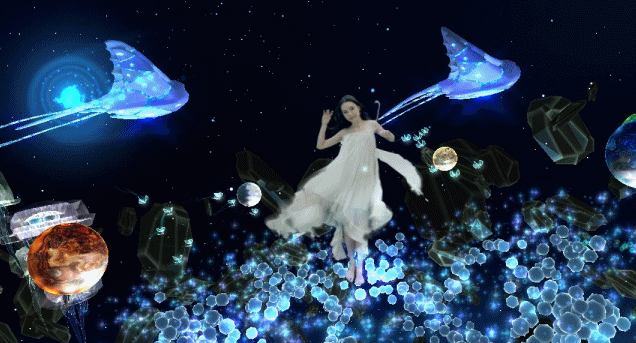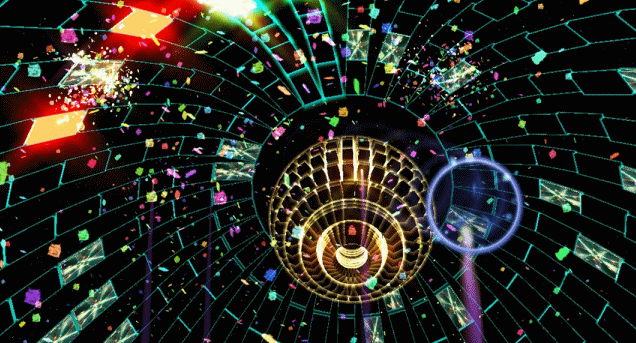 Review – Child of Eden
Review – Child of Eden
![]()
Shooter/Rhythm-Action
Rez is back but this time it’s irritating.
![]()
Rich
As a confirmed Dreamcast fanboy and collector of Xbox Live Arcade nonsense, I love Rez. Cut me and I bleed neon butterflies. The ‘games as art’ debate is a tedious one but, quite obviously, Tetsuya Mizuguchi’s masterwork stands up as one of the best examples of how a game can be an artistic piece. From its slick, gorgeous visuals to the perfect, brooding soundtrack, Rez is exhibition gaming. Show it to a non-gamer and they’ll probably coo a little. It was also a joy to play, being easy to complete but a much tougher proposition to master (like all my favourite shooting games).

Introducing Lumi. Singer, AI and all-round annoying tit.
Child of Eden was announced by Q Entertainment and Ubisoft some time ago and had us salivating uncontrollably when they revealed that it would be the spiritual successor to Rez. Early screenshots were encouragingly Rezzy with the appetite only being suppressed a little by the announcement that it would be a Kinect title. Thankfully for real gamers, Child of Eden also fully supports joypad play and, as your premier ‘can’t be cunted with Kinect’ gaming review website, that’s the version we played.

If only all viruses were this pretty.
As a Japanese game, Child of Eden‘s plot is, predictably a load of rubbery old bollocks. The game is set in Eden, the same network that Rez was in. The titular child is Lumi, the first human born on a space station – or at least a digital recreation of her memories and personality. However, Project: Lumi is under attack by a virus and it’s up to you to clean out the system. Told you. Bollocks.
Anyway, once you get past the dodgy plot and pretentious menu system, you’re into the game and, excitingly (for me anyway), it’s pretty much Rez from the get go. As before, you hold down the A button, sweep across multiple enemies with your reticule and release. In the name of progression, Child of Eden adds a couple of extra elements. Firstly, releasing the fire button on the beat of the music, increases your multiplier and is the key to getting the big scores. This adds an interesting rhythm-action element (more so than the supposed musical element of Rez which really didn’t affect things all that much). Child of Eden also equips you with a ‘purple laser thing ™’ that you use to take out specific enemies and projectiles.
|
Ian Secondary Review First off let me say, I absolutely love Rez. To the point where I have the music on my iPod, own the game on Dreamcast, PS2 and XBLA and once got into a pointless bidding war for a t-shirt on eBay just because it had the Rez logo on it. Now that we’ve got that out of the way, Child of Eden is effectively the sequel to Rez so you could conclude that I’m already biased in its favour but as much as I love pretty much everything Tetsuya Mizuguchi’s done since Sega Rally in his AM2 days, I can’t help but feel Child of Eden isn’t enough of a departure from the halcyon days of that game that starts with R. Sure the graphics are stunning compared to the wireframe and flat shaded polygons and the music is a marked contrast from the techno of its esteemed forebear. But when you Coming as it does from Tetsuya Mizuguchi, his music project Genki Rockets contributes the bulk of the music for the game including the maddeningly catchy Heavenly Star (as previously featured in PSP game Lumines II), the roots of which show up throughout. Catchy it may be, but none of the tunes reach the heights of Buggie Running Beeps or Rock Is Sponge from Rez. A slight negative is that you don’t carry over your energy level or euphoria (overdrive) The worst thing about this game is the ending. There, I said it. It’s pretty much nonsense. A half-baked J-pop karaoke abomination that leaves you thinking “whaaaaaatt?” Ultimately, Child of Eden is a victim of the fact it’s a sequel to Rez and never really reaches the lofty heights set ten years ago. Sure, it comes close at moments (level one as a whole, some spectacular set-pieces such as the planets on level 4) but falls slightly short overall. Well worth playing but I’d hesitate to pay £40 for it, a tenner less would be about right. Secondary Score: 8/10 |
Aside from those elements though, this is Rez as you know and love it. Unfortunately, a catalogue of niggles conspire to spoil the experience. For one the game is short. Very short. Five main levels, none of which are anywhere near as iconic as the five in Rez. There is less of a sense of the game being a journey, with too many bosses and sub-bosses interupting the game’s flow and nothing from Child of Eden sticks in the memory. Rez was equally short but with the definitive version of that game being a ten quid download on XBLA, you can forgive it and even on its full price Dreamcast release, it was worth it because it was so original. Child of Eden tries to make lightning strike twice and even with its spectacularly beautiful visuals, it just doesn’t make the impact that Rez did.
Also, despite the game being ridiculously short for a full price release, the levels themselves feel overly long at ten minutes each. Especially when you’re playing on Hard, getting a decent score and then one of the bullet-sponge bosses gets the better of you. For the most part this game feels like a test of endurance rather than skill, even if you can complete it with in an hour or two of unwrapping it.
The musical element, whilst being a good idea in theory, also doesn’t really work. The core gameplay mechanic of releasing shots on the beat is fine and gives you something to work on once you’ve seen all the levels but the joypad vibration doesn’t emphasise the beat which is often weak in the soundtrack so sometimes it’s very difficult to lock onto it. Also, where Rez was a dark trip, musically speaking, Child of Eden’s soundtrack is just a bit bland. There’s no menace or edge in the music and instead it just sounds like beige trance bullshit with the occasional really annoying vocal over it which leads to one of my main peeves about the game.
Every so often, Lumi (played by actress/singer Nami Miyahara) shows up in the game. Not a problem at first, but when she starts singing along to the music, everything gets a little bit twee and more than a little ‘Pop Idol’ for my liking. This comes to a head during the game’s ending as she stands there mugging to the camera, singing some bullshit J-pop nonsense and basically ruining an already blaverage experience.
As mentioned before, we’ve not reviewed the Kinect version but the leaderboards, and general gamer chatter, suggests that a regular joypad is the way to get the better scores anyway. This was potentially the game that would sell the Kinect to us at Peoww but I guess we’ll be waiting for something better to come along.
We’ve already completed the game several times and it doesn’t live long in the memory, nor does it drag you back in. Where Rez was innovative, remarkable and perfectly crafted this is irritating, dull and just very plain. If you’ve never played Rez, you might be blown away by Child of Eden but with the better game sitting on XBLA for 1200M$P, your journey into Eden should start and end there instead.
Rating: 








 6/10
6/10
